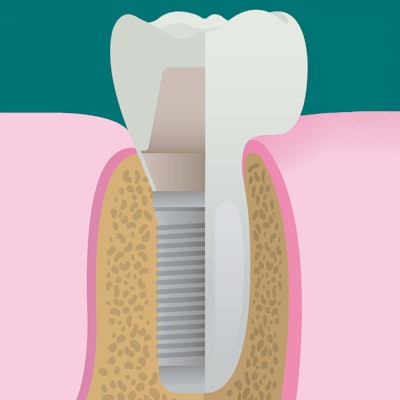
When placing implants, protecting the sinus cavity is crucial. As anatomic limitations may mean sufficient bone is not available for traditional-length implants, 8-mm tapered or parallel wall implants may be used. But is one of these designs better? A new study compared the performance of both over a year.
Researchers wanted to find out if the two types of implants differed in terms of survival rates and stability. They found no difference in survival between the two implants 12 months after placement.
"We found that implant stability was neither statistically significantly different between the two different implant designs," wrote David Simmons, DDS, and co-authors (International Journal of Implant Dentistry, May 2, 2017).
Dr. Simmons is an assistant professor in the department of periodontics at the Louisiana State University Health Sciences Center School of Dentistry in New Orleans.
Implant stability
The success of an implant largely depends on its stability. When placing implants in the maxilla, clinicians may face even more challenges, because patients often may have poor bone quality. Another complicating factor may be a patient's maxillary sinuses and the need to avoid protrusion into those. One solution to these issues is the use of shorter implants (smaller than 10 mm). To add to the initial stability, some of these shorter implants have a tapered design. Another option for these procedures is an implant with a parallel wall design.
“Implant stability was neither statistically significantly different between the two different implant designs.”
The purpose of the new study was to compare the initial stability of a tapered titanium implant (Astra Tech Implant System, OsseoSpeed TX [OSPTX], Dentsply Sirona) with that of a titanium parallel wall implant (OsseoSpeed [OSP], Dentsply Sirona). They speculated that the stability of the OSPTX implant would be greater because of its tapered design.
The researchers also studied and compared the soft-bone and standard surgical protocols. The soft-bone protocol involved cutting a narrower diameter of bone than that of the implant being placed. This may mean the practitioner underprepares the complete length of the osteotomy or the apical three-fourths of the osteotomy when the crestal bone is denser.
For their study, the researchers placed a total of 30 implants in 27 patients. All implants were 4-mm wide and 8-mm long and were placed in the posterior maxilla in areas with a minimum of 8 mm of crestal bone height.
The patients were divided into three groups:
- Group A received 10 tapered implants using the soft-bone surgical protocol.
- Group B received 10 tapered implants using the standard surgical protocol.
- Group C received 10 parallel wall implants using the standard surgical protocol.
Initially, the team recorded resonance frequency measurements (implant stability quotient) and torque values to determine implant stability. The implants were uncovered after six weeks and restored with a functionally loaded resin provisional screw-retained crown.
The researchers then recorded the stability quotient at six weeks and at six and 12 months. Twelve months after placement, the final restorations were placed. After implant restoration, bone levels were measured at six and 12 months with standardized radiographs.
The researchers found that radiographic mean bone loss was less than 0.5 mm in all groups, with no statistically significant differences among the groups. Implant survival rate at one year was 93.3%. Only two of the 30 implants failed to integrate before functional loading at six weeks, one in the soft-bone surgical group and one in the standard protocol group.
They also reported no statistically significant differences in stability quotient measurements among the three groups at all the time intervals measured.
Implant survival
While the authors did not list any study limitations, the study size was small and only involved one company's implants.
The authors concluded that survival and stability were comparable for both types of implants, which was not what they expected initially. They also found that either surgical protocol had a significant impact.
"The OSP implant system has demonstrated high survival rates ranging from 94[%] up to 100% in previous long- and short-term studies," the authors wrote. "Our findings are comparable with an overall 93.3% survival rate at one year, despite the fact that all implants were placed in the posterior maxilla."
Study disclosures
This study was supported by Dentsply Sirona. The company provided all implants and restorative parts needed for the completion of the study.
While Dentsply Sirona is the sponsor of the Restoratives Community on DrBicuspid.com, the company had no prior knowledge or influence on the publication of this article.



















